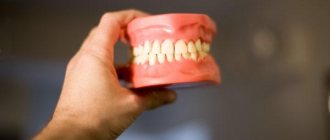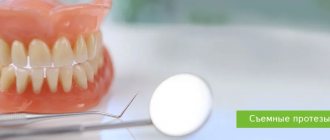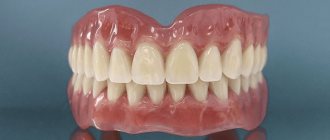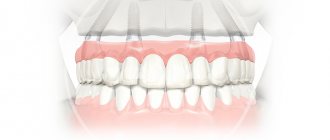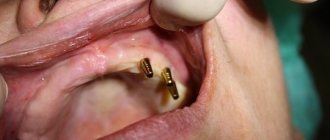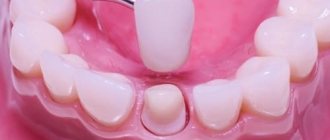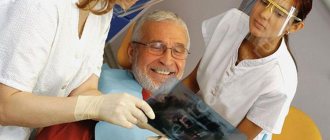Permanent prosthesis on implants. Give up removable dentures forever.
- start smiling without embarrassment,
- don’t be afraid that the prosthesis will fall out,
- eat well,
- remember the taste of your favorite dishes,
- forget about pain, sore gums,
- discomfort from bad breath,
- start living a NEW life.
Thank you! Your request will be processed within 5 minutes
We use revolutionary technologies for implanting all teeth, which have proven themselves all over the world. These are solutions that will give you a new life without problems and constant trips to the dentist.
The absence of all teeth is a problem that today faces almost every second person over 60 years of age. But researchers note that many problems that were once common among older people are becoming younger. And today, almost half of 30-year-olds already need the restoration of at least one lost tooth. We see this in our own practice - more and more people come to us with problems such as advanced periodontitis, the absence of a large number or all of their teeth.
Vladimir Alekseevich, 64 years old
“Removable dentures are a thing of the past! I am enjoying my new teeth with implants. I had no teeth for a long time, but I wore removable dentures. They put a lot of pressure on the psyche - it’s difficult to get used to them. I decided to have all my teeth implanted. I’m definitely 10 years younger both externally and internally!”
- without bone grafting
- the entire treatment takes no more than a week
- lifetime warranty
- fast and simple rehabilitation
- beautiful, comfortable and functional dentures
watch a video with a patient
Are you afraid to restore your teeth? See what this can lead to:
- you will have a lisp
- you will look much older than your age,
- you won't be able to smile confidently
- the lower third of the face will become shorter, asymmetry will appear,
- cheeks and lips will be sunken,
- you will not be able to eat normally, you will develop gastritis, stomach ulcers,
- The jaw joint will be destroyed, which will lead to constant jaw pain and headaches.
Look at the collage below - this is a photo of our patient before and after implantation of all teeth. Do you see the difference? Before teeth restoration - wrinkles, reduction of the lower third of the face, thinner lips due to the fact that they lack support in the form of front teeth. And look at the photo after - what a transformation took place. And it is not only external - all our patients note that after installing prosthetic structures they cannot contain their happy smile.
Are you ready to give up your toothless life, but don’t know which method to choose? In this article you will find the most complete information - the pros and cons of each treatment method. Or call us, we will tell you much more in 5 minutes.
Request a call
Five important questions about how to insert teeth
Before describing technologies for restoring lost teeth, we will briefly answer the most popular questions that interest almost all patients who are faced with the need for prosthetics for the first time.
- Do I need to replace teeth if I have lost them?
Dentists recommend doing this immediately and without fail. Even if the emptiness in the dentition is unnoticeable, do not delay your visit to the clinic. Lack of timely treatment leads to resorption of bone tissue, displacement of the dentition, deterioration of the bite, and can cause changes in the shape of the face and problems with the digestive system. - What teeth can be inserted?
Absolutely everything: natural incisors, canines, molars and premolars can be successfully replaced with dentures. - Does it hurt to put teeth in?
Many patients familiar with the methods of Soviet dentistry are concerned about the question of whether it hurts to insert teeth? We hasten to reassure you: modern methods of anesthesia make the treatment absolutely painless. - How long does it take to insert teeth?
It all depends on the treatment method, the efficiency of the doctors and the dental laboratory. Temporary teeth can be inserted in one visit; permanent dentures require more time. - What is the name of the doctor who inserts teeth?
The doctor who inserts teeth and performs prosthetics is an orthopedic dentist, but treatment and preparation for procedures is usually carried out by a whole team of specialists: dental surgeons, dental therapists, dental technicians.
All modern methods of restoring lost teeth
Just 20 - 30 years ago, metal teeth in the front part of the jaw were not considered something shameful. Moreover, many dreamed of inserting gold teeth, since a golden smile was associated with wealth. Today, dental treatment is technologically advanced, effective and painless, and there are many more ways to insert teeth. Despite the variety of dental services, it is very important for the patient to find good dentistry and a competent specialist who will provide professional assistance. There are hundreds of reviews online where people complain that their teeth were inserted poorly or that the inserted tooth hurts. Unfortunately, such consequences are not uncommon, and their elimination requires repeated treatment and additional costs.
All prosthetic methods are divided into two types: single restoration and complex prosthetics (when you need to replace several lost units or insert complete teeth). Single restoration in most cases is carried out using special inlays (veneers or lumineers) and crowns that are installed on natural teeth or implants. When several teeth are lost or completely edentulous, bridges or removable dentures are used, supported by implants, natural teeth or the oral mucosa. Let's look at these designs in more detail and start with regular dental crowns.
- Metal-ceramic teeth
The crown is based on a metal frame, onto which layers of ceramic are applied under the influence of high temperatures. Such designs are relatively inexpensive and are used for prosthetics of front teeth. Metal tends to oxidize, so over time a bluish outline may form around the gums, which has a bad effect on aesthetics. - Ceramic tooth
These crowns are indistinguishable from natural teeth. Modern ceramics are installed both on the anterior units and on the chewing teeth. The price of ceramic crowns is perhaps their only drawback. The cost of such products is higher than that of similar structures using a metal base. This is why not every patient can afford to have a ceramic tooth inserted. - Zirconium teeth
Today, zirconium dioxide crowns are considered the best of similar designs available on the market. They are as durable as metal crowns, and in aesthetics they are not inferior to ceramic structures. With the help of zirconium crowns, teeth are successfully inserted in any area of the jaw, but when planning to restore lost units, take into account the fairly high cost of such crowns.
Reasons for missing teeth
1-2% of the population has a genetic disorder in which teeth are initially absent or their number is abnormally small. In the vast majority of cases, the absence of lower or upper teeth is a consequence of illness or mechanical damage. Doctors at the clinic name the main reasons:
- Untreated caries or pulpitis. Tooth tissues are destroyed, in advanced cases, inflammatory processes in the gums begin, and the bone structure changes. Our dentists try to preserve every unit. But, if the process is already irreversible, then it is necessary to remove one tooth or several.
- Inflammatory processes in periodontal tissues lead to the fact that the ligament cannot hold the tooth in the socket. The crown becomes loose, destructive phenomena progress, and the gums and bone are destroyed.
- Injuries. The complete absence of teeth or partial adentia is caused by dislocations, bruises, fractures of the tooth crown or root, and other damage resulting from mechanical impact.
Sometimes teeth can be lost after suffering from somatic diseases: oncological, endocrine, and others that weaken the immune system and affect the structure of tissues.
Which crown to choose
Most of all, patients are interested in the cost of crowns and their aesthetics. Of course, you can choose a prosthesis yourself, focusing on your financial capabilities and ideas about beauty. But it is better if a doctor does this. Before starting the restoration of the dentition, the dentist evaluates the condition of the root system, gums, mucous membrane, tissues of the root part and cervical area. When choosing a prosthetic method, it is important to exclude all contraindications. They differ depending on the method of tooth restoration. The most serious are diseases of the immune system, oncology, uncompensated diabetes mellitus and periodontal inflammation. The doctor’s task is to choose the safest prosthetic option for the patient and the one that best suits the clinical picture.
What types of dentures are there for damaged teeth?
It often happens that the crown part of the tooth begins to collapse, but the root is completely healthy and sits firmly in the gum. In such cases, dentists do not recommend removal, because the root can be preserved and the crown part can be replaced with prosthetics - this is a more gentle and beneficial method for the patient to restore the defect. What dentures are available for such cases? There are several types of so-called microprostheses that will help restore the integrity of the dental crown:
- Tabs.
Simply put, these are large fillings made of ceramic or metal alloys that are made in a laboratory. The inlays exactly repeat the shape of the destroyed part of the crown and can serve as both an independent microprosthesis (restorative inlays) and a support for an artificial crown (stump). - Crowns.
The crown is the part of the tooth that we usually see and on which both the beauty of a smile and the quality of chewing food depend. Dentists install artificial crowns that cover the damaged tooth and completely cover the defects. They are made from metal-free ceramics (excellent aesthetics, good strength), metal ceramics (good strength and aesthetics) and plastic (suitable only for making temporary crowns, because such material is not very durable and stains over time). - Veneers.
For teeth in the “smile zone,” it is possible to install not entire crowns, but thin ceramic overlays on the front surfaces – veneers. They are installed if sufficient volume of the rear wall has been preserved and the microprosthesis can be securely fixed. Veneers are made from ceramics, and recently there are also designs made from zirconium dioxide. The simplest and most inexpensive option is composite veneers, formed from filling material directly on the patient’s teeth.
Orthopedic dentist at the 32 Dent clinic Veronika Aleksandrovna Ivantsova: “Microprostheses are good because they can restore both small defects (mainly veneers and lumineers) and seriously damaged teeth. We recommend our patients to fight for their own teeth to the last and, if possible, to preserve the dental unit - in no case to remove it.”
Which dentures are best to install: choose by cost
The most affordable microprostheses are inlays - they cost from 18,000 rubles. However, it is not always possible to get by with just one tab, so it is advisable for the patient to make a choice, guided not only by savings, but also by the advice of his doctor.
Veneers with lumineers will cost approximately the same - about 20-35 thousand rubles. Crowns differ slightly in price depending on the material: metal-free ceramics will cost about the same as a veneer, metal ceramics will cost 9-17 thousand rubles. Here you should choose according to the degree of destruction of dental tissues: if the defects are minor, you can get by with installing veneers. But in the case where the crown part of the tooth is seriously damaged, the installation of an artificial crown will be required.
If you have a problem similar to that described in this article, be sure to contact our specialists. Don't diagnose yourself!
Why you should call us now:
- We will answer all your questions in 3 minutes
- Free consultation
- The average work experience of doctors is 12 years
- Convenient location of clinics
Single contact phone number: +7
Make an appointment
Implantation: indications and benefits
Implantation is the most advanced dental technique that allows you to insert a tooth in place of an extracted one.
- Implants eliminate dental defects of any location and extent.
- People quickly get used to the implants. There is no discomfort, no sensation of the presence of a foreign body in the oral cavity, no problems with chewing food.
- Before implantation, there is no need to grind and depulp adjacent teeth; they remain healthy.
- Implants do not need to be changed or adjusted. With proper implantation and personal hygiene, artificial roots can last a lifetime.
- Even under increased loads, there is no risk of implants falling out or loosening.
How is an implant inserted?
The essence of this technique is to implant a titanium root into the jaw, on which a crown is subsequently installed. On average, implant healing takes from 2 to 6 months. During this time, a temporary orthopedic structure is installed for the patient’s convenience.
There are protocols for immediate implantation. Modern structures can be inserted after tooth extraction and immediately loaded with a prosthesis. Many patients are interested in whether it is painful to insert a dental implant. In fact, implants are installed quite quickly (15 - 20 minutes per tooth), and an injection of anesthesia allows you not to feel pain. If you have severe dental phobia, the doctor will suggest inserting teeth under anesthesia or sedation.
Stages of replacing all teeth with new ones
Preparatory stage
At the first stage, the patient undergoes a general blood test, which determines the presence of contraindications: diabetes, incoagulability, and immune diseases. If there are no contraindications, the patient undergoes a CT scan. The result is loaded into a special computer program that determines the location of the implants. Using 3D computer modeling, you can immediately see what your new smile will look like. The prosthetic structure is made individually and corresponds to the patient’s bite characteristics; the color of the crowns imitates the natural enamel of the teeth.
During the preparation of the oral cavity for prosthetics, the remaining teeth in the jaw are removed and the gums are treated.
At the very end of the preparation, a treatment plan is drawn up, the final cost is formed and agreed upon with the patient. After diagnosis and surgical templates are made, the day of surgery is scheduled.
Implantation of all teeth
Impressions are taken from the jaw, which are necessary for making a prosthesis. After preparation, titanium roots are implanted under anesthesia. All-on-4 implants use surgical guides and are inserted into the jaw bone through a puncture. This allows you to quickly and efficiently install artificial roots in pre-selected areas and at the same time avoid severe trauma to the soft tissues of the mouth.
In the places where the implants are implanted, an incision is made in the gum and a flap of mucous membrane is separated, and pins are screwed into the prepared bed. This compacts the bone tissue around the implant, which helps stabilize its position immediately after installation. Then the gum is sutured.
Prosthetics
After implantation, the patient is provided with temporary prostheses, which are made on the basis of casts and fully correspond to the individual characteristics of the patient. Fixed temporary prosthesis is distinguished not only by aesthetics, but also by high functionality.
They should be worn, on average, for about 6 months - during this time the implants fully take root.
Rehabilitation
After treatment, the patient must regularly come for examination to the dentist to monitor the progress of healing, in order to avoid inflammation and implant rejection.
Permanent fixed prostheses can be placed after the process of osseointegration of the implants is completely completed.
Methods for restoring anterior and chewing teeth
In the absence of teeth, the best way would be implantation, but if you have contraindications to this procedure, there are alternative options - installing a bridge with grinding of adjacent elements or a soft removable denture with clasps.
The same designs are used for chewing teeth: crowns, implants, removable and bridge dentures. The peculiarity of chewing teeth is that they are subject to heavy loads, so especially strong crowns made of zirconium dioxide or metal-ceramics are usually installed in this section.
If you need to insert 1 tooth
To restore one badly damaged tooth, an orthopedist may suggest a crown. If a tooth is missing, a bridge or implantation is required.
If you need to insert a tooth in place of a removed one
After removing a tooth, it is advisable to insert it within 1 – 2 months, since after some time the processes mentioned above begin to occur. If you want to completely restore the functionality, aesthetics, and anatomy of your tooth, dental implants are your best choice.
If you need to insert three teeth
In modern dentistry, to replace three lost teeth (in a row), a bridge prosthesis on implants is usually installed. If there is a limited budget or there are contraindications to implantation, the prosthesis is placed on the ground adjacent teeth.
If you need to completely insert teeth
Teeth restoration in cases of complete edentia is carried out using removable dentures. The best option is considered to be designs supported by implants, which guarantee the patient a good quality of life. In other cases, removable dentures are used with support on the mucous membrane and soft tissues.
In just 1 day you can achieve your goal and completely change your life.
As the name implies, with one-stage implantation with immediate loading, the entire prosthesis will be fixed immediately, that is, immediately, without waiting for the implants to fully engraft. But, of course, subject to certain requirements: when choosing implant models that can actually be loaded with a prosthesis (manufacturers write about this in the review of their products), with their correct positioning in the jawbone, with good primary stability, and also when installing a certain type of prosthesis . In particular, during the manufacture of which a metal base is created that will stabilize the installed implants, that is, keep them stationary even when you begin to actively use new teeth.
Doctors at the Smile-at-Once center are followers of the Immediate Load Implantation school (which translates from English as “implantation with immediate load”) and were among the first in Russia to use this technique in their practice. The clinic’s specialists have certificates from the International Foundation of Implantologists, Nobel, Straumann, Oneway Biomed, and are also accredited masters of immediate loading with the right to train Russian colleagues.
Undoubtedly, implantation with immediate loading in the absence of teeth is more advantageous from all sides: bone grafting is not needed (even in a complex upper jaw), there is no need to return to removable dentures, and rehabilitation is faster.
In fact, you get new teeth in 1 day, with a lifetime guarantee on treatment. One-stage implantation with immediate loading
| SIGN OF COMPARISON IN THE ABSENCE OF ALL TEETH | COMPLETE TWO-STAGE IMPLANTATION WITH DELAYED LOADING | COMPLETE ONE-STAGE IMPLANTATION WITH IMMEDIATE LOADING |
| The cost of implantation and prosthetics (in rubles, the price is “turnkey”) | 900,000 for 2 jaws on implants | from 200,000 for 1 jaw on implants (depending on the protocol and brand of implants) |
| Duration of treatment | from 2-4 to 18 months | no more than 7 days |
| Number of visits to the doctor | 10-25 | 3-5 |
| Number of hours spent with a doctor | from 7 to 30 hours | to 10 |
Is it possible to insert teeth without grinding down the adjacent ones?
Before installing classic dentures with fixation on natural teeth, preparation is required. Without grinding, restorative procedures are carried out using plastic structures with special clasp hooks that clasp the neck of a healthy tooth and thus hold the prosthesis in the oral cavity. The production and installation of such prostheses occurs much faster than in the case of overlay prostheses on implants, but you should not count on recovery in one day. If we are not talking about temporary prostheses, the creation of structures, fittings, and corrections can take several weeks.
Treatment prices: which teeth are better to insert on a limited budget
The cost of restoring one or more teeth depends on the treatment method and your budget. The most expensive treatment involves the use of implants. The cheapest thing is dental crowns.
| Insert teeth under anesthesia | An anesthesia injection costs on average 500 - 800 rubles. Treatment under general anesthesia - from 4,000 rubles (30 minutes). Sedation will cost from 1,500 rubles for half an hour. |
| Insert ceramic tooth | From 15 thousand rubles depending on the level of the clinic |
| Insert metal ceramics | From 9 thousand rubles. Depends on the metal alloy used |
| Insert a dental implant | 15 - 25 thousand for installing a budget brand of implants. 35 -50 thousand for a premium implant |
| Insert teeth completely | A removable denture on implants for one jaw costs on average from 120 to 250 thousand rubles (depending on the number of implanted implants and their brand). A regular removable denture will cost 25-50 thousand for one jaw |
| Insert zirconium teeth | From 25 thousand rubles depending on the level of the clinic. |
Stages
1 Consultation, diagnostics
2 Preparation
3 Surgery
4 Orthopedics
The doctor will visually examine your teeth and gums to make an initial assessment of their health. He will collect anamnesis, conduct a hardware examination (orthopantomogram + computed tomography), and make sure that there are no contraindications to prosthetics on implants.
Plaque and stone are removed, diseased teeth on the antagonist jaw (if there are teeth) are treated. The implant dentist prepares a treatment plan, incl. 3D model of the jaw for detailed planning of the operation. A date for the operation is set and a contract is concluded.
An injection of local anesthesia is administered. Four or six implants are installed depending on the technology used for prosthetics of a toothless jaw.
On days 3-7 after installation of the implants, a temporary (adaptation) prosthesis is fixed on them. At the end of the period of osseointegration of the artificial roots, a permanent prosthesis is placed.
Where to get teeth inserted in Moscow?
There are thousands of clinics in the capital, most of which offer almost all types of dental restoration (crowns, implants, removable and bridge dentures). Choosing a clinic is quite difficult, so we advise you to pay attention to important nuances. Study the clinic’s website: it should contain detailed information about specialists, treatment methods and technologies, as well as relevant diplomas and certificates. Read patient reviews about dentistry on third-party resources. Directly during the consultation, do not be afraid to ask questions and find out details. A good doctor will always give comprehensive information and offer various treatment options. The search engine on our website will help you find reliable dentistry.
